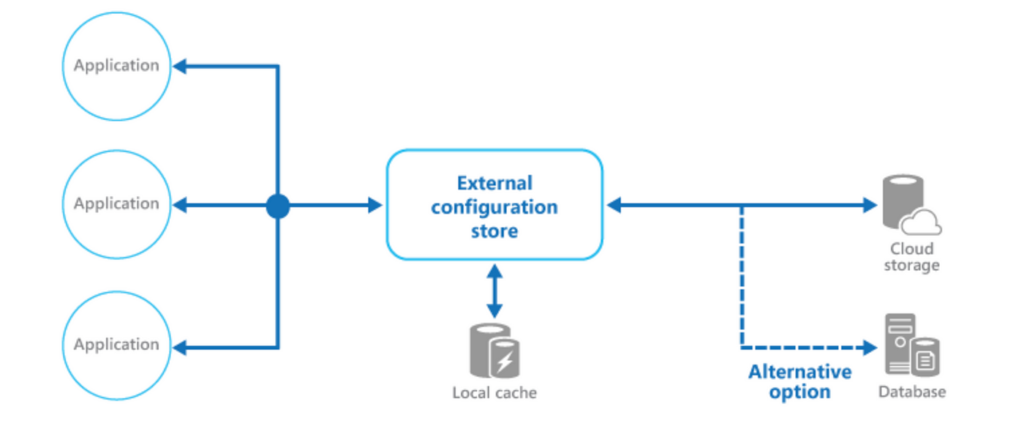Configuration Externalization Performance
In this tutorial we are going to discuss about the Configuration Externalization Performance implications. So, we’ve seen the power of the Configuration Externalization Pattern. Its ability to simplify and secure configuration management is impressive, isn’t it? However, before you jump into implementing this pattern, let’s put our critical thinking hats on. It’s important to understand some considerations and implications. Ready to delve deeper?
Externalizing configuration in a software system involves storing configuration settings outside the application code, typically in configuration files, environment variables, or configuration servers. This practice is crucial for maintaining flexibility, enhancing security, and enabling easier updates without redeploying applications. However, it also comes with certain performance implications that need to be considered:

1. Startup Latency:
- Initial Configuration Load: When an application starts, it needs to fetch its configuration from an external source. Depending on the complexity and location of the configuration (e.g., remote server), this can introduce additional latency during the startup phase.
- Dependency on External Services: If the configuration is stored in an external service (e.g., a configuration server), the application’s startup time may depend on the availability and responsiveness of that service.
2. Runtime Performance:
- Configuration Retrieval Overhead: Accessing configuration settings from an external source can incur runtime overhead, especially if the configuration needs to be frequently accessed or if the retrieval process involves network calls.
- Caching Strategies: To mitigate runtime overhead, applications often cache configuration settings locally. While this improves performance, it adds complexity in ensuring the cache is kept up-to-date with the latest configuration changes.
3. Scalability:
- Configuration Server Load: In large-scale systems, a configuration server may become a bottleneck if it needs to handle frequent configuration requests from numerous application instances.
- Horizontal Scaling: Externalizing configuration facilitates horizontal scaling of applications, as new instances can fetch the necessary configuration at startup. However, ensuring consistent and performant access to the configuration server at scale requires careful planning and infrastructure.
4. Network Latency and Reliability:
- Network Latency: Fetching configuration from a remote server introduces network latency. This can be particularly impactful in environments with high network latency or intermittent connectivity.
- Network Reliability: Applications become dependent on the reliability of the network and the external configuration service. Network issues can lead to delays or failures in retrieving configuration, impacting the application’s performance and reliability.
5. Security Overhead:
- Configuration Security: Externalizing sensitive configuration (e.g., database credentials, API keys) necessitates secure transmission and storage. Implementing encryption and secure access controls can introduce additional processing overhead.
- Authentication and Authorization: Ensuring secure access to configuration settings often requires authentication and authorization mechanisms, which can add to the latency and complexity of configuration retrieval.
6. Change Management:
- Dynamic Configuration Updates: Externalizing configuration allows for dynamic updates without redeploying the application. However, implementing efficient and low-latency mechanisms to detect and apply these changes in real-time can be challenging.
- Consistency: Ensuring consistency across multiple application instances when configuration changes are made can be difficult, particularly in distributed systems.
Mitigation Strategies
- Local Caching: Implement local caching of configuration settings to reduce the frequency of external fetches. Use cache invalidation strategies to ensure the cache is updated when the configuration changes.
- Bulk Retrieval: Fetch configuration settings in bulk rather than making multiple small requests. This reduces the number of network calls and improves efficiency.
- Configuration Service Resilience: Design the configuration service for high availability and resilience. Use techniques like load balancing, replication, and failover to ensure the service remains responsive under load.
- Efficient Data Formats: Use efficient data formats (e.g., JSON, YAML) for configuration files to minimize parsing overhead.
- Monitoring and Alerts: Implement monitoring and alerting for the configuration service to detect and address performance issues promptly.
By carefully considering Configuration Externalization performance implications and implementing appropriate mitigation strategies, you can effectively manage the trade-offs of externalizing configuration while maintaining the desired performance and reliability of your applications.
That’s all about the Configuration Externalization Performance. If you have any queries or feedback, please write us email at contact@waytoeasylearn.com. Enjoy learning, Enjoy Microservices..!!